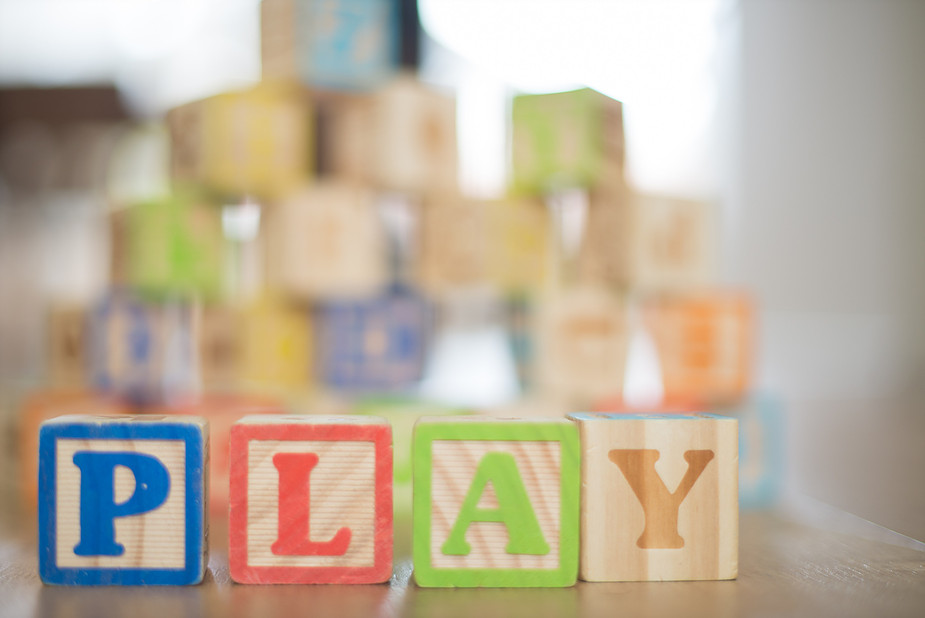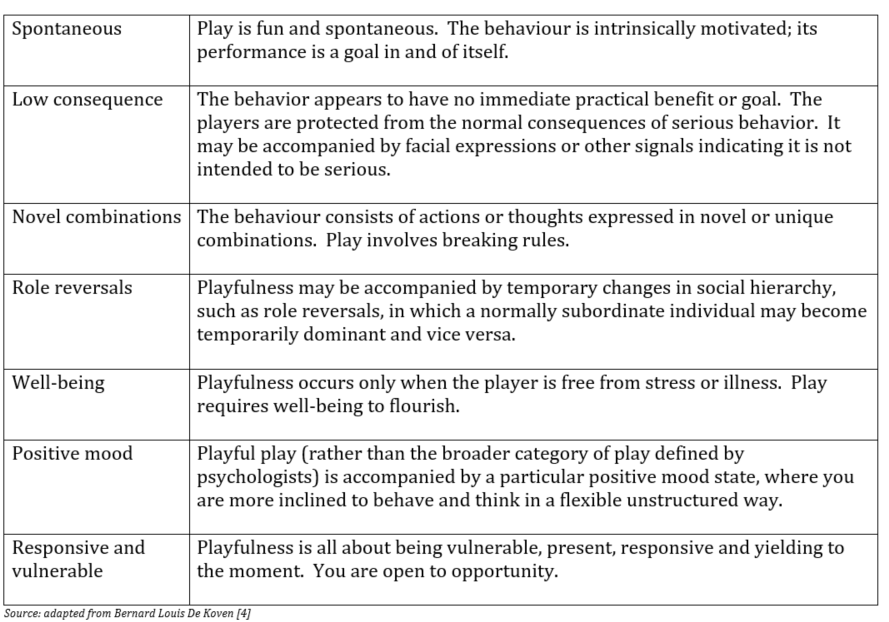The secret to high-performing teams may well be in building a culture of playfulness. Having fun at work may be more than just about letting off steam. It not only helps foster creativity, enhances problem solving but encourages participation by all members of your team.

This article considers:
-
What is playfulness?
-
Why is playfulness important?
-
How do you build a culture of play?
What is playfulness?
At its simplest, playfulness is about having fun. The Oxford Dictionary defines it as “the quality of being light-hearted or full of fun.”
In everyday parlance, it is about being spontaneous, outgoing, creative, fun-loving, lighthearted, cheerful, frisky, good-natured, spirited.[1] Some businesses have introduced games rooms, ping pong tables, bring your dog to work day, pinball machines. This is a good start but what really drives results is the interactions between teams solving problems.
People who exhibit high levels of playfulness are better at coping with stress, more creative, able to solve complex problems better and more likely to succeed academically.[2]
It is important to differentiate between play and playfulness. While playing golf or spending hours on PlayStation are technically play, we are focused on doing activities in a playful manner. To be playful, “You don’t need toys or games or costumes or joke books. But you do have to be open, vulnerable, you do have to let go.” [3]
The key criteria for recognizing playful behaviour:

Why is playfulness important?
Playfulness has some important benefits in the workplace:

-
Reduces stress: According to Scientific American, fun and laughter release endorphins, happy hormones which counteract cortisol, the stress hormone.[5] In other words, fun counteracts stress, one of the biggest inhibitors of cognitive performance. People who work in high stress roles like the military, paramedics and firefighting naturally use humour as a coping mechanism to deal with otherwise unbearable situations. Research by Lynn Barnett, University of Illinois Associate Professor, is that people who are playful are less likely to encounter stress but when they do, they’re better at coping with it:
“People who are playful don’t run away from stress, they deal with it – they don’t do avoidance.” [6]
-
Creativity: Play stimulates our “right brain” which is what allows creativity, lateral problem solving and independent thinking. According to the Neuro Psychiatry Reviews the frontal lobe is “the part of the cortex that is most important for creativity, being critical for divergent thinking.”[7] Creativity is what “enables us to come up with innovative products, services and solutions that serve our customers and, ultimately, generate revenue.”[8]
-
Flow: Play facilitates cognitive flow because if solving a problem is just a game, we are far less likely to worry so much about consequences of failure. Flow is a powerful mind-state that allows us to be hyper-productive; it is however inhibited by stress and also by concerns about other people’s perceptions of our performance. Play, as noted above, reduces stress and also makes us less self-conscious.
-
Encourages participation: Play allows everyone in a group to take part and is a good equalizer, allowing people to forget (albeit temporary) relative status and position. In playful play, roles may be reversed, it is marked by cooperation between the players and it is non-competitive. Every one of your staff has within them a genius idea that could double your revenue and transform your business – they are just too scared to share it. Play encourages people to share their view and ideas.
-
Brain function and memory: In 1964, Marion Diamond published a landmark paper about brain function in rats. Neuroscientists conducted an experiment:
“raising some rats in boring, solitary confinement and others in exciting, toy-filled colonies. When researchers examined the rats’ brains, they discovered that the ‘enriched’ rats had thicker cerebral cortices than did the ‘impoverished’ rats … Subsequent research confirmed the results – rats raised in stimulating environments had bigger brains. They were smarter, too – able to find their way through mazes more quickly.” [9]
According to playfulness expert, Patrick Bateson, many scientists, artists and composers who were famous for creativity, were also extraordinarily playful. Alexander Fleming, the scientist who discovered the anti-bacterial properties of penicillin, was well known for his playfulness. His superiors accused him of treating research like a game and when people asked what he did, he said that: “I play with microbes” and went on “… it is very pleasant to break the rules and to be able to find something that nobody had thought of.” [10]
How do you build a culture of play?
The irony is not lost on me. The minute you identify “play” as something important for profits, it stops being play. Furthermore it is difficult to legislate for increased playfulness. Imagine an edict from management: be more “playful”. It is a bit like the joke about the Royal Navy mandating that “floggings will continue until moral improves”.
Playfulness is difficult to objectively measure and it is also hard to create KPIs. That said, as a leader you intuitively know when your culture is the opposite of playful (serious, staid, non-spontaneous); you also know the associated behaviours that kill play (formality, master-servant leadership style); as a leader you need to weed those behaviours out.
Some strategies for building a culture of play:
Build culture: Zappos, the online shoe store, went from startup to $1 billion in sales in about 8 years. Tony Hsieh, the CEO says: “You have to build a culture first, then your brand and profits will follow.”[11] Zappos have an ugly holiday sweater day, a Chief Happiness Officer and one of their values is “create fun and a little weirdness.”
Leadership: As a leader you must lead by example. Find ways to make work fun for the team. This is an everyday activity: lighthearted jokes, banter, friendly competition and positivity. Organise regular team breakfasts, dinners or drinks. Make sure you do something that suits your personal style and tone, but at the same time experiment with different events: annual retreats or fancy dress parties.
Deloitte have as one of their core cultural values:
“We have fun at work, and celebrate our achievements and personal milestones, both big and small. To do this we … embrace a playful culture with a serious intent.”
Trust: A pre-condition to a culture of playfulness is “being safe”, in other words it requires a deep and complete sense of shared trust. When people feel safe, valued and protected, they will push the boundaries and try new things. A management style of “public beheadings” and ridicule for failed projects will not engender the risk-taking required. It is important that you set the boundaries clearly – playfulness doesn’t mean you can tolerate overtly offensive humour or other unacceptable behaviours.
Hiring: Playfulness can be a trait that you actively seek when you hire and retain staff. There is a management fable that when researchers introduced a new monkey into a cage of other monkeys, it became the average of the others. So when added to a cage of aggressive monkeys, it became aggressive. When added to cage of good-natured monkeys, it adopted the same temperament.
Environment: An important aspect of facilitating play is the physical environment. If your office is like a library where noise and chatting is frowned upon; if it mimics the supercilious tone of an old-fashioned club, replete with oak paneling and expensive artwork it is hardly the place for light-heartedness. Google is famous for creating fun, crazy spaces for their teams: gaming rooms with bean-bags, basketball courts, hammocks, indoor bike-lines. It is all about making people feel relaxed, at home, comfortable.
Role play: You can also mimic “role play” from childhood but instead of playing “doctors and nurses” or “cowboys and Indians”, you can do mock negotiations; imaginary client complaint handling; or even do a dry run on pitches. By rehearsing in a low risk environment, your staff can experiment and practice different techniques. They will have fun, as well as building valuable skills.
Tim Brown, in his recent TED Talk, “Tales of Creativity and Play”, gives a number of exercises you can do with your team to encourage playfulness.[12] One simple example was sitting your team down with a piece of blank paper and a pencil. Everyone then has thirty seconds to draw the person sitting next to them. This usually results in nervous laughter and embarrassed apologies at their terrible artwork. Brown argues it demonstrates our inherent fear of the judgment of our peers, in turn driving a reluctance to share ideas. When given the same task, children invariably are far less self-conscious; happily sharing their masterpiece with others, having almost no fear of judgment. Brown argues that we need to try and mimic this state in the workplace if we are to achieve creativity.
Summary
A culture of playfulness is a powerful tool for building high-performing teams. It reduces stress, encourages participation, enables flow and drives creativity. Leaders can foster this culture by weeding out behaviours that stymie play; by hiring and retaining staff who are playful; by embracing a core value of having fun and celebrating; and making the physical workplace less stoic. At the end of the day, you will probably spend most of your productive adult life at work – it may as well be fun!
About the author
Nick Humphrey is the managing partner of Hamilton Locke. He is the Chairman of the Australian Growth Company Awards and author of a number of best-selling books on business and leadership. His latest book is Maverick Executive: Strategies for Driving Clarity, Effectiveness and Focus, published by Wolters Kluwer.
Sources:
[1] Patrick Bateson and Paul Martin, “Play, Playfulness, Creativity and Innovation,” Cambridge University Press, Pg 13, July 2013
[2] Leon Neyfakh, “What playfulness can do for you”, The Boston Globe, 20 July 2014, https://www.bostonglobe.com/ideas/2014/07/19/what-playfulness-can-for-you/Cxd7Et4igTLkwpkUXSr3cO/story.html
[3] Bernard Louise De Koven, “Playfulness”, A Playful Path, 11 February 2015, https://www.aplayfulpath.com/playfulness/
[4] Bernard Louise De Koven, Ibid
[5] Jennifer Welsh, “Why Laughter May be the Best Pain Medicine”, LiveScience, 14 September 2011, https://www.scientificamerican.com/article/why-laughter-may-be-the-best-pain-medicine/
[6] Bernard Louise De Koven, Ibid
[7] Sarah Lipoff, “Right Brain or Left Brain: Children and Creativity”, Funderstanding, 26 April 2011, http://www.funderstanding.com/theory/child-development/right-brain-vs-left-brain-children-and-creativity/
[8] Annemarie Steen, “Branding Fun: The Rise of Playfulness at Work”, Sparksheet, 6 November 2012, http://sparksheet.com/branding-fun-the-rise-of-playfulness-at-work/
[9] Gwen Dewar, Ph.D, “The cognitive benefits of play: Effects on the learning brain”, Parenting Science, https://www.parentingscience.com/benefits-of-play.html
[10] Patrick Bateson, “Playfulness and creativity”, ScienceDirect, 5 January 2015, https://www.sciencedirect.com/science/article/pii/S0960982214011245
[11] Annemarie Steen, Ibid
[12] Tim Brown, “Tales of creativity and play”, Ted, May 2008 https://www.ted.com/talks/tim_brown_on_creativity_and_play